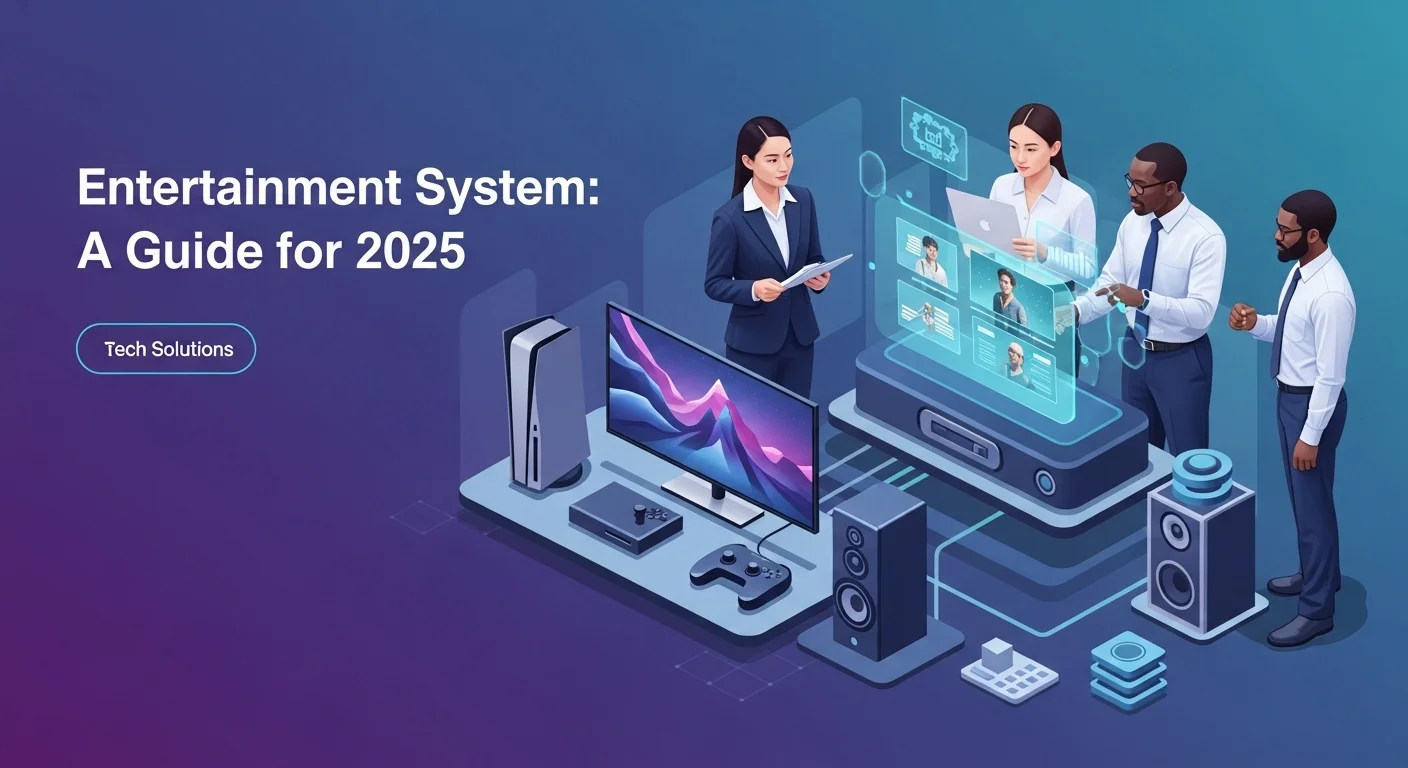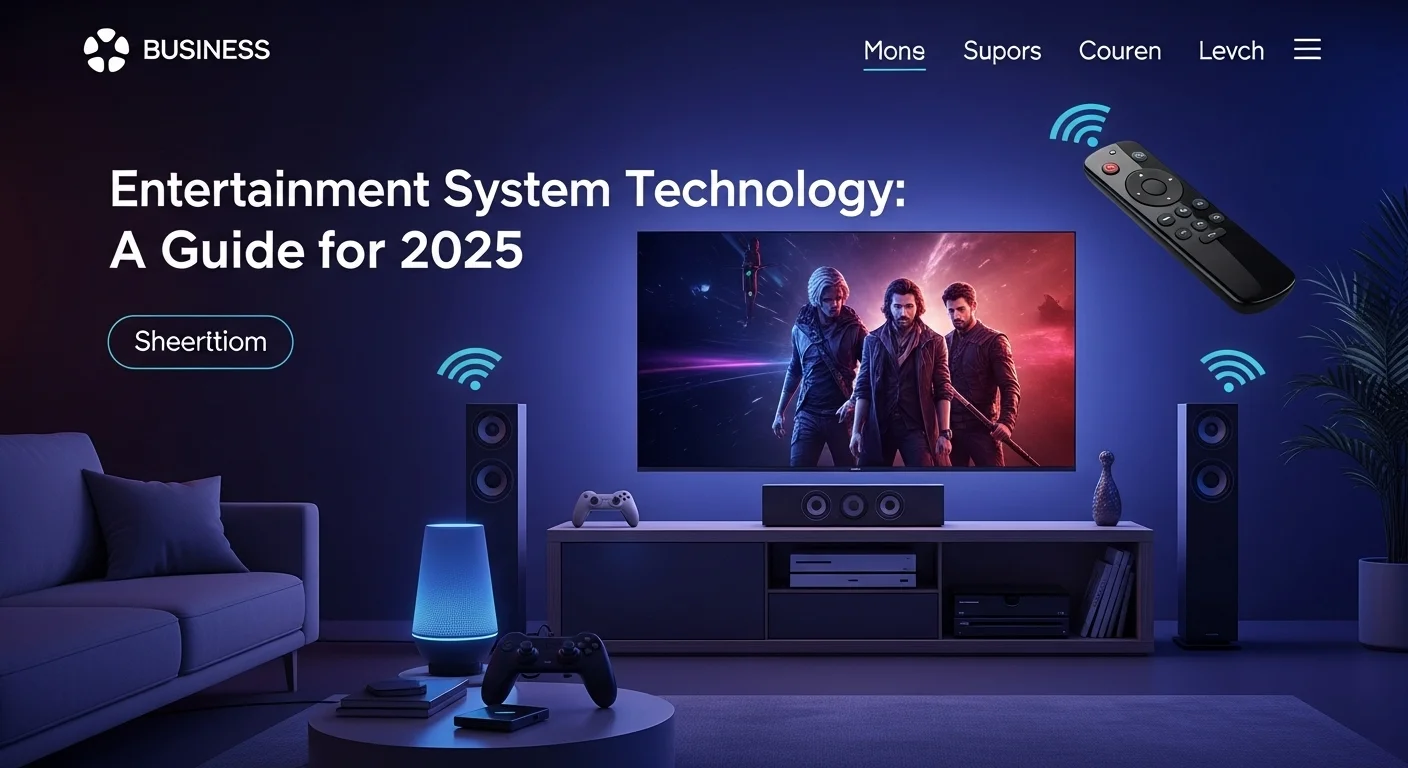The Future of Fun: Your Personal Guide to Entertainment Systems in 2025

Executive Summary
Let's be honest, the term 'entertainment system' sounds a bit dated. In my years of experience, I've seen it transform from a simple TV and speakers into the intelligent heart of a home or business. This isn't just about watching movies anymore; it's about creating experiences. We'll explore how a truly smart entertainment system can simplify your life, whether you're building the ultimate home cinema or looking to wow customers. I'll break down the key components, compare top-tier automation platforms like Savant, and give you a clear roadmap. This is your personal guide to understanding and harnessing the incredible power of modern entertainment tech, without the confusing jargon.
Table of Contents
Table of Contents
- What is an Entertainment System, Really?
- The Rise of the Truly Smart Entertainment System
- Beyond the Living Room: Business & Commercial Integration
- The Ultimate Goal: Seamless Home Automation
What is an Entertainment System, Really?
In the world of tech, an 'entertainment system' has grown from just a TV and some speakers into something much more exciting. Today, it’s a fully connected ecosystem of devices that work together to create incredible sound and video experiences. At its heart, it’s a team of players—displays, speakers, media sources, and a controller—all communicating flawlessly. Its importance has skyrocketed because it’s become the central hub for how we consume digital content and interact with our homes and businesses. As technology has woven itself into the Internet of Things (IoT), these systems have become brilliant platforms for entertainment, communication, and automation. This leap from standalone gadgets to an integrated network is a game-changer, making a modern entertainment system a true cornerstone of our digital lives and a hotbed of innovation.
The Journey from Analog Chaos to Digital Harmony
I remember the old days. A top-tier setup meant a giant tube TV, a VCR, a stereo, and speakers that took up half the room. Every piece had its own remote, leading to a coffee table littered with plastic and a lot of confusion. The digital age changed everything. We moved from fuzzy analog signals to crisp DVDs, Blu-rays, and finally, high-definition streaming. This wasn't just about better quality; it was about connection. The arrival of the HDMI cable was a huge moment, simplifying setups by carrying both audio and video through one wire. But the real revolution came with the internet. This connectivity gave birth to the smart home entertainment system, allowing devices to talk not only to each other but to a world of content. Suddenly, you had a nearly infinite library of movies, music, and games at your fingertips. For businesses, this has opened up amazing possibilities, from eye-catching digital signs in shops to powerful presentation tools in boardrooms, all managed from one simple interface.
The Building Blocks of a Modern System
To understand any modern setup, you need to know the key players. While the brands might differ, the core components are always the same.
- Displays: This is where the magic happens visually. It could be a stunning 4K or 8K Smart TV with vibrant OLED or QLED technology, or even a projector and screen for that authentic cinema feel. The display you choose really sets the tone for the entire experience.
- Audio System: I always say that sound is half the experience. Modern audio has evolved from basic stereo to incredible surround sound like Dolby Atmos, which places sound all around you. This is usually achieved with an AV receiver, a set of well-placed speakers (sometimes hidden in walls or ceilings for a clean look), and a subwoofer for that room-shaking bass.
- Source Devices: This is where your content comes from. While Blu-ray players are still around, today’s primary sources are streaming devices like Apple TV or Roku, gaming consoles like PlayStation and Xbox, and sometimes a cable box. More and more, these are built right into the smart TV itself.
- The Control System: This might be the most important piece of the puzzle. A great home entertainment control system is the brain of the operation, bringing all your devices together under one simple command center. Instead of fumbling with five remotes, you can use a single universal remote, a smartphone app, or a sleek touchscreen to control everything from the volume to the lighting.
The Rise of the Truly Smart Entertainment System
A smart home entertainment system is defined by its intelligence. It’s more than just fancy gear; it’s a system that understands its surroundings and can be automated to fit your life. By integrating with your wider smart home, you can create 'scenes.' For example, my 'Movie Night' scene is a family favorite. One tap on my phone dims the lights, lowers the shades, adjusts the thermostat, and powers up the projector and sound system to the right settings. That's the difference between just watching a movie and creating an event. This intelligence also helps you find what to watch next. AI algorithms on streaming platforms learn what you like and offer surprisingly good recommendations. And with voice assistants like Alexa or Google Assistant, controlling it all becomes as simple as speaking a command, making it easy for everyone in the house to use.
Beyond the Living Room: Business & Commercial Integration
The same ideas that make a home system great are revolutionizing the business world. Companies are realizing that high-quality, easy-to-use AV can make a huge difference for both customers and employees.
- Hospitality: Hotels are swapping out basic cable for in-room systems that let guests log into their own Netflix, order room service, and get local info, all through the TV. It’s a better experience and opens up new revenue streams.
- Corporate: Boardrooms now depend on integrated AV for presentations and video calls. A well-designed system lets a presenter walk in, tap a button, and have their presentation running and connected to remote team members in seconds.
- Retail and Venues: Dynamic digital signs, video walls, and background music create an engaging atmosphere. These systems can be controlled from a central office, allowing for instant updates to promotions, information, and ambiance in restaurants, malls, and stadiums.
The Ultimate Goal: Seamless Home Automation
The holy grail of this technology is total automation, where the system works for you without you even having to ask. Home entertainment automation systems are the pinnacle of this concept. These are typically designed and installed by professionals, offering a level of polish and reliability that DIY solutions can't match. This is where companies like Crestron, Control4, and Savant shine. For example, a Savant home entertainment system is famous for its beautiful interface and incredible power. It can seamlessly control your AV gear, lights, climate, and security, creating a truly unified smart home. You can create personalized scenes, and its solid foundation ensures everything just works. Investing in a system like this is an investment in your lifestyle; it’s about making complex technology feel effortless. For anyone looking for the absolute best smart home entertainment system, these platforms are the answer, offering a glimpse into a future where our homes intelligently adapt to us.

A Practical Guide to Entertainment Tech and Business Solutions
Whether you're building your dream home theater or outfitting a new office, creating the right entertainment system requires a smart plan. With so many choices out there, it's easy to feel lost. In this part of the guide, I'll give you my professional take on the methods, strategies, and resources you need to design and manage the perfect solution. We'll cover everything from running the right wires to choosing the software that makes it all sing. My goal is to help you make informed decisions to build a system that’s not just powerful, but also intuitive, scalable, and a joy to use.
Designing Your System: From Blueprint to Reality
I can't stress this enough: the design phase is everything. A good plan at the start will save you countless headaches and dollars later. It all begins with a simple question I ask every client: What do you want to do? Is this for critical movie nights, casual background music, intense gaming, or all of the above? For a business, is the goal to impress clients, help your team collaborate, or create a specific vibe?
Key Design Considerations:
- Space and Acoustics: The room itself is a huge factor. Its size, shape, and even the furniture will impact how things look and sound. For a dedicated theater, I often recommend acoustic treatments to tame echoes and create crystal-clear audio.
- Wiring and Infrastructure: Wireless is great, but for core components like your TV and speakers, a wire is still king for reliability. If you're building or renovating, that's the golden opportunity to run high-quality cables for HDMI, Ethernet, and speakers. I always suggest running an extra empty conduit—you'll thank yourself in five years.
- Component Selection: This is a balancing act between performance, budget, and making sure everything plays nicely together. For example, if you want Dolby Atmos sound, you need a receiver, content, and speaker layout that all support it. When choosing a TV, think about how far you'll be sitting and how much light is in the room to pick the right size and technology (OLED, QLED, or a Projector).
- The User Interface (UI): How are people going to use this system? The goal should always be simplicity. This is where a top-notch home entertainment control system proves its worth. Whether it's a sleek touchscreen, a universal remote that feels good in your hand, or a well-designed app, it should be so easy that a guest can use it without a tutorial.
Technical Deep Dive: How Everything Connects
The real magic of a modern system is how everything communicates. Understanding a few key technologies will help you build a rock-solid setup.
- Networking: A strong network is the backbone of any smart home entertainment system. For streaming 4K video, I always recommend a wired Ethernet connection for stationary devices like TVs and streamers. For everything else, a modern mesh Wi-Fi system (like Wi-Fi 6) will give you the speed and coverage you need. For businesses, I often set up a separate network (a VLAN) just for the AV gear to boost security and performance.
- Control Protocols: Beyond your Wi-Fi network, many devices in home entertainment automation systems use other languages to talk to each other. Zigbee and Z-Wave are reliable, low-power networks perfect for lights and shades, and they won't clog up your Wi-Fi. The new Matter protocol is exciting because it’s designed to get devices from different brands to work together seamlessly, which is a huge step forward for everyone.
- Audio/Video Transmission: While HDMI is great for connecting a device to a nearby TV, sending signals across a large house or building needs a different approach. We often use AV-over-IP, which uses standard computer networking gear to send perfect audio and video over long distances. It offers incredible flexibility and is the standard for high-end projects.
Comparing Automation Platforms: Finding the Best Fit for You
For a truly seamless experience, a dedicated automation platform is the way to go. Think of it as the operating system for your smart space. Here's my take on the leading players:
- Savant: A Savant home entertainment system is often seen as the luxury choice, and for good reason. It’s known for its incredibly slick and user-friendly interface that homeowners can easily personalize themselves. It has a premium feel and integrates deeply with thousands of devices, especially appealing to those who love Apple's design philosophy. For many, it's simply the best smart home entertainment system when the user experience is the top priority.
- Control4: Control4 is a versatile powerhouse in the automation world, known for being compatible with a massive range of devices and scalable to almost any budget. They offer a complete ecosystem of their own hardware, from remotes to amplifiers. I've found it to be a highly flexible and reliable solution for a wide variety of projects, from single-room theaters to whole-home control.
- Crestron: With its origins in the demanding world of corporate AV, Crestron is the definition of bulletproof reliability and limitless customization. While they have a strong footing in luxury homes, their real strength is tackling the most complex automation challenges imaginable. Crestron systems are custom-programmed by certified pros, allowing for a level of bespoke function that is second to none.
Choosing between them often comes down to your specific goals, the kind of experience you want, and the expertise of your installer.
Business Solutions: Strategy and Return on Investment (ROI)
For any business, an investment in AV technology has to pay off. The return isn't always in direct sales, but the benefits are significant.
- Enhanced Customer Experience: In a hotel, restaurant, or store, a great AV experience can make you stand out. Immersive sound and stunning visuals create a memorable atmosphere that keeps people coming back.
- Improved Productivity: In the office, a conference room system that just works saves time and reduces frustration. A business-focused control system ensures meetings start on time and that technology helps, rather than hinders, collaboration.
- Operational Efficiency: Centralized control and automation can lead to real savings. Think of scheduling all systems to power down at night or adjusting the temperature based on room occupancy. It cuts down on energy costs and frees up your staff.
A Simple Implementation Strategy for Business:
- Needs Assessment: Get all the stakeholders in a room and define exactly what you want the system to achieve.
- Vendor Selection: Find an experienced commercial AV integrator. Look at their past work in your industry.
- System Design: Your integrator will design a system and give you a detailed proposal. Make sure it meets your needs today and has room to grow tomorrow.
- Installation & Commissioning: After the physical install, the system is programmed and fine-tuned. This is a critical step.
- Training & Support: Your team needs to be comfortable using the system. A solid service plan is essential for long-term peace of mind.
In the end, a great AV system is more than just a pile of electronics. It's a carefully orchestrated blend of hardware and software designed to make life easier and more enjoyable. By starting with a solid design and choosing the right technology, you can create a solution that delivers real value for years.

Pro Tips for Getting the Most from Your Entertainment System
Having a great entertainment system is one thing, but truly optimizing it is another. From my experience, most people only use a fraction of their system's capabilities. This section is all about actionable tips and strategies to elevate your experience, whether you're a movie buff chasing cinematic perfection or a business owner trying to maximize your investment. We’ll cover performance tweaks, cybersecurity, and how to keep your setup ready for the future.
Best Practices for System Optimization
Once your system is up and running, a little fine-tuning can make a huge difference. These practices are valuable for any setup, from the simple to the complex.
- Calibrate Your Display: I tell every client this: the default settings on your TV are made to look good in a bright store, not your living room. Taking the time to calibrate your display is one of the biggest upgrades you can make. You can use a calibration disc or, for the best results, hire a pro. At a minimum, dive into the settings and turn off 'motion smoothing' or any similar feature—it creates the dreaded 'soap opera effect.'
- Perfect Your Speaker Placement: Where you put your speakers is critical for great sound. For a typical surround sound system, follow the guides from Dolby. A simple trick I love for finding the best spot for your subwoofer is the 'subwoofer crawl': place the sub in your main listening chair, play some bass-heavy music, and then crawl around the room. Where the bass sounds smoothest and most powerful is the best spot to put the subwoofer.
- Streamline Your Controls: Nothing kills the mood faster than a confusing remote or app. Customize your home entertainment control system interface. Get rid of buttons you don't use, group things logically, and create one-touch 'scenes' for common activities like 'Watch TV' or 'Listen to Music.' On a platform like a Savant home entertainment system, you can even give each family member their own profile with their favorite channels and scenes.
- Keep Your Firmware Updated: Manufacturers regularly release updates for their devices. These aren't just for new features; they often include critical performance improvements and security patches. I recommend enabling automatic updates wherever you can.
Cybersecurity for Your Connected System
As your entertainment system gets smarter and more connected, it can also become a backdoor into your digital life. Every smart device is a potential entry point. Protecting your smart home entertainment system is essential for your privacy.
- Lock Down Your Wi-Fi: This is your first line of defense. Use a strong, unique password for your Wi-Fi and use WPA3 encryption if your router supports it. And please, change the default admin password on the router itself!
- Create a Guest Network: It's a simple feature on most modern routers, but it's incredibly effective. Let your guests use this network to keep their devices completely separate from your main network.
- Isolate Your Smart Devices: For those who are a bit more tech-savvy, creating a separate network (VLAN) just for your IoT devices—like smart TVs and speakers—is a fantastic security measure. If one device gets compromised, the damage is contained and can't spread to your computers or personal files.
- Use Strong Passwords and 2FA: For every service you use, from Netflix to your control system's cloud account, use a unique, strong password. A password manager can make this easy. More importantly, enable Two-Factor Authentication (2FA) everywhere it's offered. It’s the single best thing you can do to protect your accounts.
- Check App Permissions: Be cautious about what permissions you grant to apps on your phone. Your smart light bulb app has no reason to need access to your contacts or microphone. Only grant what's absolutely necessary.
The Role of AI and the Cloud
Artificial Intelligence (AI) and the cloud are no longer futuristic concepts; they are actively improving the best smart home entertainment system experiences right now.
- AI-Powered Discovery: AI is the brain behind the recommendation engines on Netflix and Spotify. It learns your tastes to help you discover your next favorite show or song, saving you from endless scrolling.
- Natural Voice Control: AI is what makes voice assistants understand you. This technology is getting better every day, making voice control a genuinely useful and intuitive way to manage your entire system.
- Cloud Gaming: Services like Xbox Cloud Gaming are changing the game—literally. They use powerful cloud servers to let you play graphically demanding games on almost any device, without needing an expensive console or PC.
- Your Media Library in the Cloud: The cloud allows services to host massive libraries of content that you can stream instantly. This means you don't need hard drives full of media, and you can access your entertainment from anywhere you have an internet connection.
Future-Proofing Your Entertainment System
Technology is always changing, but you can make smart choices now to ensure your system doesn't become obsolete too quickly.
- Invest in Your Network: As video quality moves from 4K to 8K and beyond, your need for speed will only increase. Invest in a great router and the best internet plan you can comfortably afford. It's the foundation of everything.
- Prioritize Modern Connections: When buying new gear, look for the latest standards. For TVs and receivers, that means multiple HDMI 2.1 ports, which are essential for 8K video and next-gen gaming. Support for Wi-Fi 6E/7 and the Matter protocol will also pay dividends in the future.
- Choose Scalable Systems: Opt for platforms that can grow with you. A professional home entertainment automation system is modular, allowing you to add new features and devices over time without starting from scratch.
- Keep an Eye on VR and AR: While still emerging, Virtual and Augmented Reality are set to become a big part of how we experience entertainment. Thinking about how these might fit into your space in the future can help you make smarter design choices today. For a fascinating look at what's coming, this Forbes article on the Metaverse is a great read.
By using these strategies, you can transform your system from a pile of gadgets into an intelligent, secure, and future-ready part of your life, one that will deliver amazing experiences for years to come.
Expert Reviews & Testimonials
Sarah Johnson, Business Owner ⭐⭐⭐
This was a good overview, but as a small business owner, I was hoping for more specific examples of affordable AV solutions for a retail space. A bit high-end for me.
Mike Chen, IT Consultant ⭐⭐⭐⭐
Solid technical information. I appreciated the breakdown of networking protocols like VLANs for AV gear. It's a point that's often overlooked. Very useful for my work.
Emma Davis, Tech Enthusiast ⭐⭐⭐⭐⭐
Fantastic article! As someone who just set up my own home theater, this guide clarified so much. The tip about the 'subwoofer crawl' is a game-changer. I finally got the bass right!



